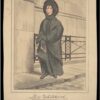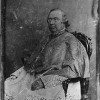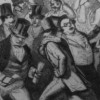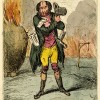
Rebecca Nesvet, “Miss Whitehead, ‘The Bank Nun’”
An urban legend maintains that early in the nineteenth century, one Miss Whitehead, colloquially known as “the Bank Nun,” frequently visited the Bank of England to accuse that institution of destroying her brother, a financial forger. This essay traces the evolution of this legend. I contend that in 1837, an obscure comic sketch reacted to that year’s major financial crisis by dredging up the Romantic-era case of financial forger Paul Whitehead and focusing on his surviving sister. Displacing her brother’s notoriety onto her, the sketch reinvents her as “the Bank Nun,” a grotesque magnet for lingering Romantic-era anxieties about the circulation of paper credit, financial forgery, and women. A succession of plagiarisms, retellings, and reappraisals of this ephemeral sketch and its portrait illustration made the Bank Nun a folk heroine of enduring resonance. Via this iconic figure, Romantic-era economic controversy haunts London today.

Kathleen Frederickson, “British Writers on Population, Infrastructure, and the Great Indian Famine of 1876-8”
This article examines British writing about the 1876-8 famine in southern and western India. In British newspapers and journals, the turn to thinking about famine in terms of the total population obscured the extreme variations in food access that worsened with rising economic inequality. When the British press in the late-1870s turned to human causes of famine, they either argued that India’s population overburdened India’s land, or suggested that more rail construction would prevent enough deaths sufficiently to mitigate British responsibility for famine conditions. The turn to population-based arguments helped either to perpetuate the belief that famine was a quasi-natural part of India or to parse the sudden increase in the frequency and severity famines in India under British rule.

Mario Ortiz-Robles, “Animal Acts: 1822, 1835, 1849, 1850, 1854, 1876, 1900”
What does the history of animal rights have to tell us about Victorian Britain – and how do legislative gains, specifically Parliamentary Acts, appear when read in tandem with theatrical performances and literary depictions of animals? This article reads the former category alongside the latter two, paying particular attention to how artistic representations of animals, including Rudyard Kipling’s The Jungle Book, blur the lines between human and animal behavior. In doing so, it sheds light on how animals were figured as part of a racialized discourse, using Foucault’s notion of biopower to help frame the complex ways animal rights, and animalism, were portrayed in politics and culture.

Miriam Burstein, “The ‘Papal Aggression’ Controversy, 1850-52”
This article provides an overview of the political, religious, and cultural response to the restoration of the Roman Catholic hierarchy in England. The Vatican’s decision to go ahead with this bureaucratic change was misunderstood in England, with immediate and unexpected consequences. Protestants across a wide range of denominations reacted harshly to the announcement, with repercussions not only for Catholics, but also for the Oxford Movement in the Church of England itself.

Florence S. Boos, “The Education Act of 1870: Before and After”
Nineteenth-century England was relatively backward in providing its citizens with basic skills. Education was highly stratified by class, and pervasive child labor, sectarian religious competition, and reluctance to levy taxes for schools all delayed the systematic provision of elementary education for the children of the working-classes. The Education Act of 1870, which acknowledged and codified for the first time a Crown responsibility for elementary schools, was a watershed in the provision of universal instruction. Even this advance had been hotly contested, and it would be another twenty years before (almost) all British children benefited from a primary school education. Critics of the Education Act of 1870 and its successors noted that the system of inspections it mandated tended to encourage rote learning and limit the range of subjects taught, and those who favored secular public education, including workers’ organizations, resented continued government support for sectarian schools.

Ann Curthoys, “Settler Self-Government versus Aboriginal Rights, 1883 – 2001: The Shocking History of Section 70 of the Western Australian Constitution”
This essay describes the failed attempt by the British government to retain control over Aboriginal policy even while establishing self-government for the colony of Western Australia. The British made the attempt through a clause (Section 70) in the colony’s 1889 Constitution, which provided that £5000, or one per cent of the annual revenue of the colony when it exceeded £500,000, be set aside annually for the welfare of Aboriginal people. In addition, the British-appointed and controlled Governor, rather than the colonial government, would manage Aboriginal policy. The settlers hated the clause and in 1897 succeeded in persuading the British government to repeal it. Yet Section 70 was not forgotten, a legal challenge in the Australian High Court to its repeal failing as recently as 2001. The story of Section 70 provides a window for viewing the conflicts and collusions between imperial authorities and their settler colonies on questions of Aboriginal policy.

Lynn Shakinovsky, “The 1857 Financial Crisis and the Suspension of the 1844 Bank Act”
The 1857 financial crisis began in the United States and reached England in October of that year with the fall of the Liverpool Boro’ Bank. This essay examines representations of and responses to the crisis by some of the major figures and key sources of the period. While an increasingly widespread acknowledgement of the inevitability, at times even of the desirability, of crisis manifests itself in various representations and discussions of the financial crisis, the diverse ideological assumptions and expectations of various writers, politicians, and journalists proffer widely differing explanations and solutions. These range from Marx and Engels who saw in the crisis the opportunity for revolution, to entrenched capitalists who regarded it as a necessary occurrence for the promotion of further growth, to politicians and bankers who called for new interventions in the Banking system. Through an investigation of political, journalistic, and academic responses to the 1857 crisis and the suspension of the Bank Charter Act of 1844, this paper explores the political and economic significance of the crisis for mid-century global capitalism and the Banking system.

Carolyn Lesjak, “1750 to the Present: Acts of Enclosure and Their Afterlife”
Although certain events, such as the General Enclosure Act (1801) and the Swing Riots (1830), punctuate the history of enclosure in Britain, enclosure was in actuality a centuries-long process that involved thousands of Acts of enclosure, numerous forms of resistance from commoners and the newly industrial working class, and the destruction of an entire way of life subtended by common right. Given its long durée, enclosure challenges the idea of a discrete historical “event,” a challenge this entry attempts to take up, both in terms of considering how we look back to the past and forward into the future as members of a now fully global commons.

Janice Carlisle, “On the Second Reform Act, 1867”
The Second Reform Act, arguably the signal political event of the 1860s, enfranchised large numbers of working-class men by setting a new financial standard for the suffrage. It became law only after members of Parliament vigorously debated the failed reform measure proposed by the Liberal party in 1866 and the successful, though much amended, Conservative bill of 1867. The law created new problems when it terminated compounding, the customary practice by which landlords added to their tenants’ rent the sums that covered the poor rates and other taxes that those tenants owed. The Second Reform Act therefore exemplifies the way in which one piece of reforming legislation in the mid-Victorian period often created the need for another. Completing at least some of the work that the 1867 act had been expected to do, the Assessed Rates Amendment Act in 1869 reinstated compounding; in doing so, it liberalized the qualifications for voting in the boroughs of England and Wales in a way that moved Britain toward the goal of universal (manhood) suffrage.

Barbara Leckie, “‘The Bitter Cry of Outcast London’ (1883): Print Exposé and Print Reprise”
Andrew Mearns’s The Bitter Cry of Outcast London is acknowledged as a pivotal document in nineteenth-century British housing reform. It offers an exposé of the housing conditions in one section of South London in 1883 and concludes with a call for social reform. With its explicit and often shocking exposé of housing conditions, its illustration of what it calls the “godlessness” of the poor, and its support for the long-contested need for state intervention, the pamphlet excited considerable attention. In this paper I examine the ways in which the form and rhetoric of this pamphlet—its language, structure, and reliance on print exposé—shape, and arguably compromise, its call for social reform.
